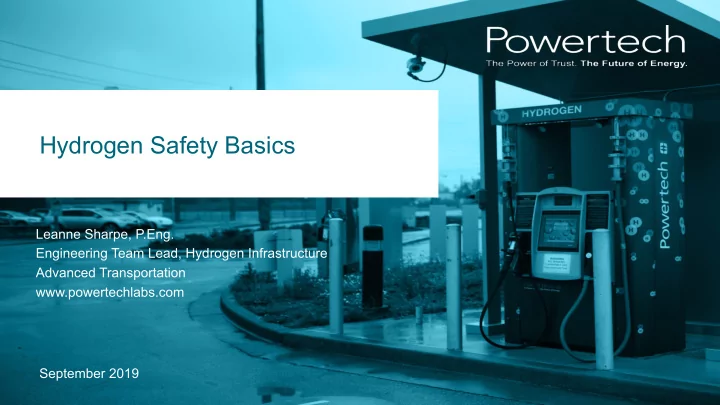

Hydrogen Safety Basics Leanne Sharpe, P.Eng. Engineering Team Lead, Hydrogen Infrastructure Advanced Transportation www.powertechlabs.com September 2019
Powertech’s 11-acre facility located in Surrey, B.C. offers 15 different testing labs and is home to a broad range of Introduction to Powertech Labs approximately 200 scientists, engineers, and technical specialists. Advanced Transportation Substation Technology and Testing T&D Technology and Testing High Pressure Testing High Power Testing High Voltage Testing CNG & Hydrogen Testing Insulating Oil Testing Mec Mechanic hanical T al Tes esting ting Hydrogen Infrastructure Fuel Analysis Cable Testing DCFC Hardware Evaluation Oil Purification Non-Destructive Testing Workplace & MURBS Charging Environmental Testing Condition Assessment Infrastructure Field Testing Services EV-Grid Impact Studies Power System Studies Grid Modernization Generation Technology and Testing Grid Modelling Distribution Automation Ma Materials E erials Evalua aluatio tion n Intelligent City Accelerator Grid Performance Optimization Failure Analysis Fa AeroMACS Certification Dynamic Security Assessment Weld Repair Consulting Smart Metering Infrastructure Systems Coating & Corrosion Power System Reliability Generator Testing Assessment Generator Modelling Condition Assessment
Hydrogen Gas Comparison to other Fuels Hydrogen Natural Gas Propane Gasoline Ø In many ways, Hydrogen is safer than Yes, if compressed; Odourant Added? No Yes No conventional fossil fuels: no, if liquefied Ø Hydrogen is 14 times lighter than air – Toxic? No No No Yes therefore, it rises into atmosphere at a rate of 20 m/s (72 km/hr). Vapour Density (relative to air) 7% 55% 152% 400% Ø The flames emit low radiant energy, which Autoignition Temperature 585°C 540°C 490°C 232°C means that they’re less likely to move to surrounding areas and spread fire. Ignition Energy (mJ) 0.02 0.29 0.26 0.24 It is non-toxic. Ø Flammability Range (% in gas-to- 4 to 75 5 to 15 2.1 to 10.1 1.4 to 7.6 air volume ratio) Explosive Energy (gTNT/m 3 ) 2 7 29 44 Diffusion Coefficient (cm 2 /s) 0.668 0.16 0.1 0.05 0 Seconds 3 Seconds 1 Minute
Gasoline Tanker Fire
Hydrogen Gas Properties, Safety & Testing Hydrogen Characteristic Potential Hazard Safety Measure Colourless, odourless and tasteless Undetectable to human senses Detection sensors Leaks and embrittlement of certain Low viscosity and small atoms that can Correct material selection, leak materials, potentially causing structural be absorbed into materials detection systems, ventilation failure Storage container and component Low volumetric energy density Stored at high pressures design and testing, and pressure relief devices Not breathable (like any other gas that Can accumulate in confined spaces Ventilation and leak detection systems displaces oxygen) and act as an asphyxiant Wide flammability range of 4% to 75% Leaks are a concern Ventilation and leak detection systems Ignition by even a small spark can be Ventilation, grounding, and removal of Low ignition energy possible possible ignition sources Burns with a pale blue flame that is Flame detectors and leak detection nearly invisible in daylight, produces no Potential for undetected flames systems smoke, emits little heat
Hydrogen Fueling Station Safety Safety Planning & Design Tools Hazard and Operability Analysis (HAZOP) Ø Failure modes and effects analysis, what-if analysis, checklist analysis, fault tree analysis Ø Probabilistic risk assessment Ø Codes and standards specify requirements for equipment design and installation of hydrogen Ø fueling stations to ensure that hydrogen is produced, stored, and dispensed safely. Safety Considerations Ø Operational Features of the Station Ø Use of pressure relief valves, hydrogen detectors, explosion-proof electrical systems, clearance distances, etc. Ø Materials Selection used in Components Ø Sufficient strength for application, resistance to hydrogen embrittlement and permeation effects Ø Functionality of Components Ø Equipment suitable for service conditions How Do We Make Components Safe? Ø Look at experiences in other industries with high pressure gas Ø Review failures experienced to date involving high pressure hydrogen Ø Establish “worst-case” service conditions for hydrogen fueling stations Ø Develop standards for the testing components using simulated “worst-case” service conditions Ø Testing of components Ø Implement quality systems to control manufacture of components and assembly of stations
Safety/Destructive Studies Wide variety of testing done on all hydrogen components and storage cylinders to ensure safety in vehicles and fueling stations. Hydrogen Release Crush/Impact Damage Tolerance Hydrogen Ignition H2 Embrittlement Vehicle Fire
Storage Tanks – Impact Resistance Test (gunfire penetration - 35 MPa hydrogen)
Recommend
More recommend